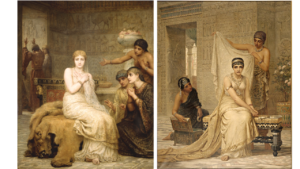Object of the Month: May 2016
Vashti Refuses the King’s Summons
Oil on canvas, Signed and dated: E. Long, 1879 (middle right on servant’s bracelet)
Queen Esther
Oil on canvas
Edwin Long, R.A.
English, 1829–1891
Click on the links throughout the article to view additional artists’ works and reference material.
Esther is one of only two women who merit an entire book in Scripture, but that is not the only characteristic that makes Esther unique. The elegant style and tightly woven plot used in the telling of her story has also made this book one of the most admired literary works in western as well as eastern culture.
Nineteenth-century British artist Edwin Long “translates” this storytelling power into a visual format. A member of the London Royal Academy, Long was known for his meticulous attention to historical detail and for his ability to use visual texture to enrich his scenes. His painting of Vashti (left, M&G’s Collection) captures the dramatic opening of the biblical narrative—Vashti’s refusal of the King’s summons.
The servant girl in the foreground of this work then becomes Queen Esther in his second painting (right). The demure pose and restrained, melancholy expression of both Queens not only illuminates each character but also anticipates the tension that will soon unfold in each of their lives.
Both works were first exhibited at Burlington House in 1879 (though not side-by-side). Vashti Refuses the King’s Summons is now part of the collection at M&G; an original variant copy by Edwin Long of Queen Esther currently hangs in the National Gallery of Victoria, Melbourne.
Click on the video to hear art collector Andries van Dam’s response to M&G’s Vashti painting; he is the 2nd speaker.
Donnalynn Hess, Director of Education
Published in 2016
